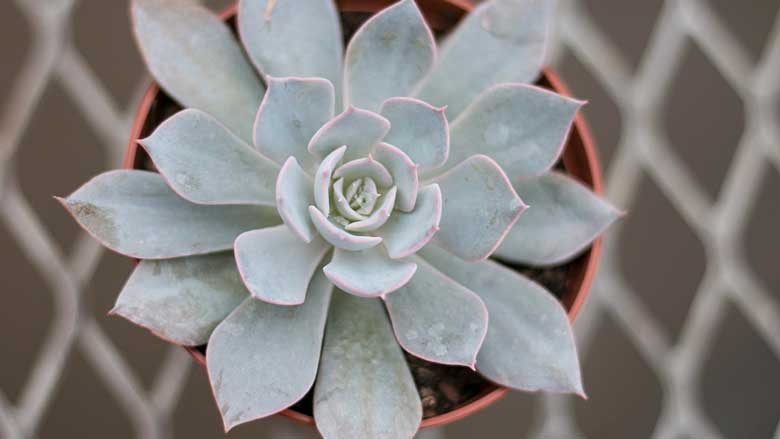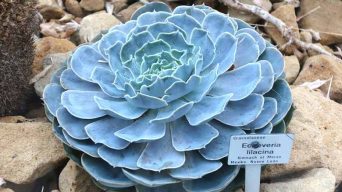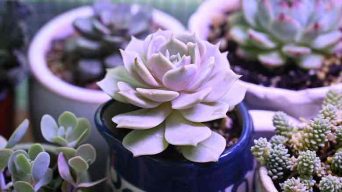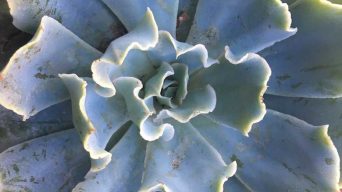Growing succulents is something that many people find very interesting.
Succulents are plants that can survive in arid environments and require little water. They can, therefore, be grown with little to no maintenance at all.
One particularly interesting succulent plant is the Echeveria peacockii.
It is a relatively hardy succulent that can survive in most climates and is beautiful enough to be grown as a houseplant.
This article will give you all the information you’ll need to properly take care of, grow and propagate this beautiful plant.
Overview
Echeveria peacockii, also known as Echeveria desmetiana and Peacock Echeveria, is a fast-growing succulent from the family Crassulaceae.
The leaves are bluish-gray and form stemless rosettes with red tips.
The Rosettes can reach a diameter of up to 4.4 inches (11 cm) with leaves that are about 2 inches (5 cm) long and 1 inch (2.5 cm) broad.
The flowers are pink-orange and grow on stalks that are up to 10 inches (25 cm) long in the early summer.
How To Care for Echeveria Peacockii
Echeveria peacockii care is not too complicated. This succulent plant is generally easy to grow, can adapt well to harsh conditions, and rarely get sick or infested with pests.
However, the Peacock Echeveria plant has specific care requirements that are important for growing healthy plants for many years.
Below you’ll find the essential information you need to know about caring for Echeveria peacockii.
Sun Exposure & Light Requirements
The Echeveria peacockii succulent plant thrives in bright, direct sunlight but can grow in partial shade as well.
Keep your plants indoors near a window that gets full bright, indirect sunlight all day long.
Avoid the harsh midday sun when placed outdoors and provide partial shade for the hottest parts of the day, especially in warmer climates.
Peacock Echeveria succulents need approximately six hours of bright light per day to thrive.
Watering Requirements
Echeverias need very little water. Like most succulents, their adaptations to arid climates and soil meant to retain as much water as possible make them relatively tolerant of underwatering but not necessarily of overwatering.
Echeveria peacockii plants should be watered once every 1-2 weeks in the summer and once every 2-3 weeks in the winter.
If you live in a humid area particularly prone to rain or fog, your Echeveria peacockii plants probably won’t need as much water because of the extra humidity.
Before watering, make sure the soil has dried out enough to not remain wet for more than a day.
Sticking your finger in the soil is the best way to know if your Echeveria peacockii succulent needs water. If it’s dry several inches down, it’s time for a drink.
Another indicator of dryness is the Echeveria leaves falling off. If your Echeveria peacockii’s leaves are falling off at a brisk pace, it may be time to water them.
When you water your Echeveria peacockii plants, ensure the excess water drains from the drainage holes in the bottom of your pot to avoid root rot.
If your succulent shows any sign of rotting, you should stop watering until the root system has dried up and the plant has started to heal.
Soil Requirements
Echeveria peacockii succulents love to be planted in a well-draining soil mix.
A fantastic alternative is a cactus or succulent potting soil designed for a well-draining soil mix.
If you don’t have any of these things, just mix equal parts potting soil, coarse sand/gravel, and perlite.
This can be used for most succulents.
Temperature and Humidity
Echeveria peacockii succulents like warm weather.
They need a sunny location and temperatures ranging from 65 to 70 degrees Fahrenheit (18-21°C) during the day and above 55 degrees Fahrenheit (13°C) at night.
Echeveria peacockii succulents grow best in dry environments and need very little humidity.
However, avoid exposing them to dry, windy locations that may cause the delicate leaves of the plant to dry out.
Fertilizing
No fertilizing is necessary for the Echeveria peacockii. Although it can benefit from occasional fertilization in the growing season (spring and summer), it requires a balanced liquid fertilizer diluted to half-strength.
You should avoid fertilizing during the winter or temperatures are below 45 degrees Fahrenheit.
The recommended amount of fertilizer is one teaspoon per 15 liters of water once every month during the growing season.
The Echeveria peacockii is sensitive to over-fertilization, and excess fertilization will cause damage to the plant’s root system.
It’s always best to err on the side of too little rather than too much.
Potting and Repotting
Echeveria peacockii plants are most often grown in outdoor gardens or as houseplants.
When grown as houseplants, their pots are usually placed in terracotta or unglazed pot with drainage holes.
Since Peacock Echeveria plants do best when they’re slightly pot-bound, it’s recommended that you repot them every few years.
When repotting an Echeveria peacockii, it’s best to use a slightly larger pot than the previous one.
Pruning
Echeveria Peacockii is not necessary to prune.
If you want to, prune the Echeveria peacockii succulent whenever it looks like it needs some grooming or you need more room for this eye-catching succulent plant.
You can do so by removing any dead leaves or flowers. This will prevent rot or diseases from setting in due to the decaying matter.
If your Echeveria plant has become leggy and elongated due to lack of sunlight, you can cut the stem at a joint so it branches out horizontally, making more room for these peacockii leaves.
Pests and Diseases
Echeveria peacockii is a robust plant from dry areas of Mexico. However, it can be affected by pests and diseases just like any other succulent plant.
Here are the main ones:
Scale Insects
Scale insects are tiny insects that attach themselves to the succulent’s leaves and stem, feeding on its sap.
They look like small bumps that are easily identified due to their light color.
If they aren’t treated quickly, they can lead to significant damage.
There are several ways to treat them, depending on the scale at hand.
If the infestation is light, you can easily remove the bugs by hand and rub them with a piece of cloth soaked in soapy water.
You can spray the plant with a homemade mixture of soap and water or neem oil for a more serious problem.
Aphids
Aphids are small insects with soft bodies and a mouth that can pierce the skin of leaves.
They suck out their juices, leaving a sticky secretion on the surface of the plant’s leaves, which is unsightly and attracts dirt.
You can take a water and soap solution and remove them by hand or use insecticidal soap to remove them.
Mealybugs
Mealybugs are tiny white insects that attach themselves to the surface of leaves and stems, sucking out their juices.
They give off a cottony substance and secrete honeydew, which is where they get their name.
You can use an insecticidal soap or neem oil solution to remove them.
Root Rot
Root rot is caused by fungi that are present in the soil.
It manifests itself through the yellowing of the leaves at the base of the plant and can be accompanied by a bad smell.
The stems become brittle, dry up and die, often followed by other parts of the plant.
It’s very dangerous because it spreads quickly to the rest of the plant and can even kill it if left untreated.
To avoid root rot, be sure to let any excess water drain from the pot after watering.
You should also use a soil that allows proper drainage or add perlite to your existing soil mix.
How to Care for Echeveria Peacockii in Winter
Echeveria peacockii succulents can be grown outdoors in most climates, but they should be brought indoors and grown as houseplants during the cold winter months.
While it is safe to grow them near a sunny window where the temperature is about 65°F, it may be necessary to provide supplemental light for them during the colder months.
The best way of doing this is with grow lights that are specifically designed for
Echeveria peacockii succulents planted in outdoor gardens or containers require very little care.
However, they should always be watered sparingly and only when the soil is completely dry.
Reduce watering for winter months as well unless the temperatures are above 40°F (5°C).
Winter care for Echeveria peacockii plants should be minimal.
For example, they should not receive more than 1/3 of the water given to them during warmer seasons.
In addition, these plants should be watered only when the top layer of soil is dry to the touch.
How To Propagate Echeveria Peacockii
Echeveria peacockii propagation is easy and cheap, but it takes some time.
You can propagate Echeveria by leaf cuttings or offsets. The choice is yours!
Propagating By Leaf Cuttings
To propagate Echeveria peacockii by leaf cuttings, just follow these simple steps:
- Take a fresh, firm, and healthy leaf from your succulent plant.
- Let the cutting dry for several hours or overnight to callous over to reduce the risk of rotting later.
- Lay the leaf on top of moist soil about halfway under the surface – keep it in indirect sunlight.
- Ensure that your potting mix is not too wet, water only when the soil is dry.
- Keep the plant in indirect sunlight and wait for new roots to appear.
- When the new roots are about 3 cm long, you can sever the leaf from the stem and plant it in a succulent or cacti mix soil.
- Keep in partial sun to full shade, water very sparingly, and wait for your new plantlet to grow!
And that’s all there is to it!
Propagating By Offsets
To propagate Echeveria peacockii by offsets, just follow these simple steps:
- Take a fresh, firm, and healthy offset from your succulent plant.
- Let the cutting dry for a few days to callous over to reduce the risk of rotting later.
- Lay the offset on top of moist soil about halfway under the surface – keep in indirect sunlight.
- Make sure that your potting mix is not too wet. Water only when the soil is dry.
- Keep the plant in direct-filter sunlight and wait for new roots to appear.
- After a few weeks, new roots should have formed fully, and the offset can be cut from the stem and planted in a succulent mix soil.
- Water very sparingly, keep in partial sun to full shade, and wait for your new plantlet to grow!
And that’s all there is to it! Good luck with growing Echeveria peacockii!
Final Thoughts
Growing succulents are often thought of as very complicated, but it doesn’t have to be.
The most important thing is to ensure that you are providing all of the basics- water, sunlight, proper drainage, etc.
The Echeveria peacockii succulent plant is straightforward to care for in general, especially if you are growing it indoors.
It is a beautiful and unique succulent that will look great in your home.
Whether you keep it in just one location or have multiple around the house, it’s sure to be appreciated by all who see them.







